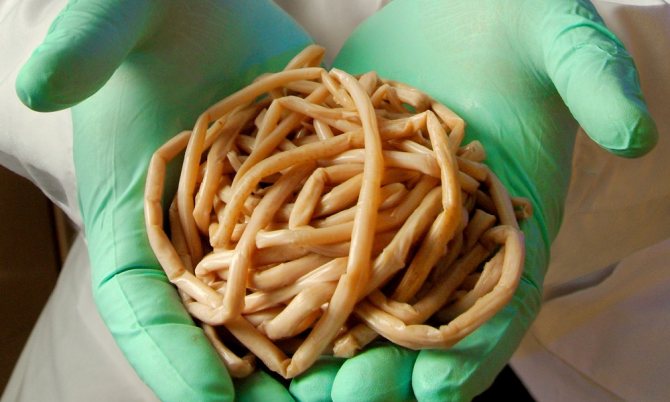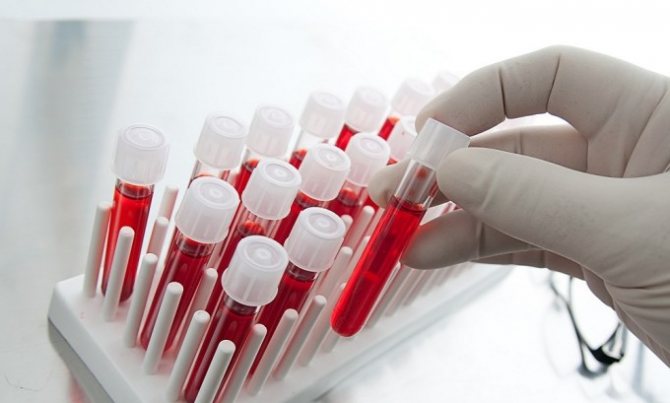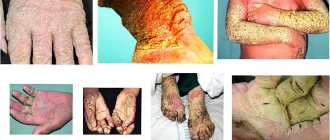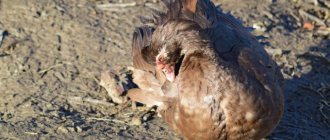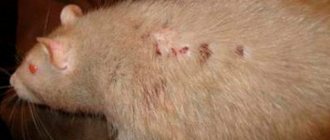Enterobiasis is the most popular helminthic infestation in the world. This disease is caused by pinworms, which every person had to meet at least once in their life. The risk of infection is especially high in children attending organized groups. According to statistics, pinworms are found in every second child and every third adult inhabitant of the planet. Enterobiasis is not considered a dangerous pathology, but it can cause physical and psychological discomfort, inflammation of the genitals in girls and women, decreased immunity and a number of other problems. It is not difficult to cure this disease, but the likelihood of re-invasion is extremely high. To prevent infection, it is necessary to understand where and how pinworms can be infected in everyday life, what to do to avoid the disease.
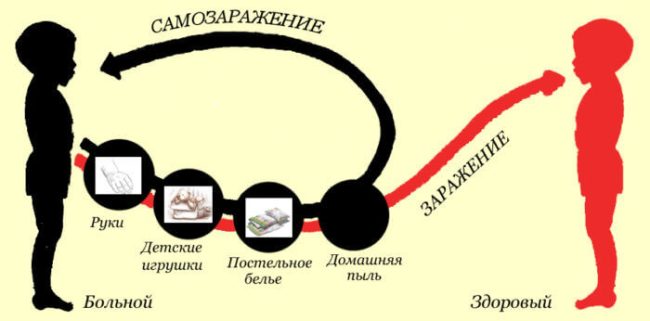
Development life cycle of pinworms
In order to become infected, it is necessary for a person to swallow the invasive eggs. Thus, they enter the digestive system, reach the intestines, where larvae hatch from the eggs. Thanks to special holes on the head, the larvae are easily attached to the intestinal walls. For development, the larvae feed on the contents of the intestines, blood.
When the larva develops to a mature individual (about 2 weeks), the stage of active reproduction begins. After mating, the males die and are taken out during a bowel movement.
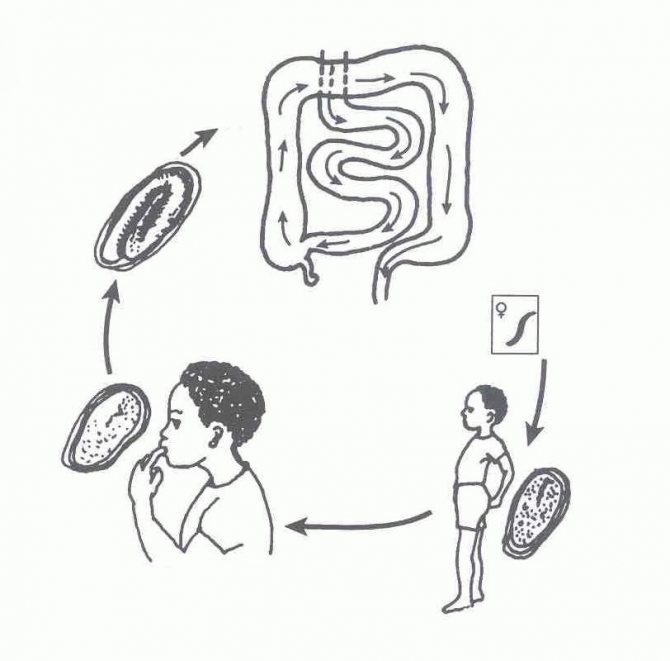

Pinworm life cycle
A month later, the female starts laying eggs. To do this, at night, when the intestinal muscles are relaxed, she gets out and lays eggs around the anus, between the folds, in the perineum.
This process is accompanied by the release of a special enzyme that provokes irritation and itching.
The female lays about 20,000 eggs, which develop within 6 hours. After that, she dies. The conditions around the anus are most favorable for the development of eggs - the temperature is kept around +36 degrees, the humidity is about 90%.
Ripe pinworm eggs become invasive, and larvae can already hatch from them. In the external environment, eggs retain their vital functions from a couple of hours to several months - it all depends on various factors.


Pinworm eggs under a microscope
Chlorine-containing agents do not work on them, but direct sunlight is deadly for eggs. Usually pinworms live for 20 days, extremely rarely - 40.
General characteristics
The pinworm is a round helminth that reaches a length of 2 to 12 centimeters. Adult parasites are localized in the lower part of the small intestine, in the large intestine. Interestingly, sexually mature females are able to leave the anal ring after moving to the rectal area to breed offspring on the epidermis in the perianal area.
Females can exist for 7–20 days. Eggs acquire the ability to infect other creatures at the end of 5 hours after they are laid.
Pinworm infection can be recognized by several symptoms:
- the presence of itching sensations in the perianal zone;
- decreased appetite;
- painful sensations in the abdominal region.
Ways of pinworm infection in adults
| Factors that increase the likelihood of infection | How can you get pinworms |
|
|
Diagnostic methods
It is recommended to take tests to identify pinworms once a year. For this, a study of feces, blood is carried out, a smear is taken near the anus. Such barrier tests are carried out when a child enters a kindergarten and school, during a routine check of catering workers, during pregnancy. In addition, with the characteristic clinical picture of enterobiasis, they also cannot be avoided.
Stool analysis is often not informative, since the eggs of the worms are not always present in it. The most reliable diagnostic method is scraping. The material obtained in this way is carefully studied under a microscope.
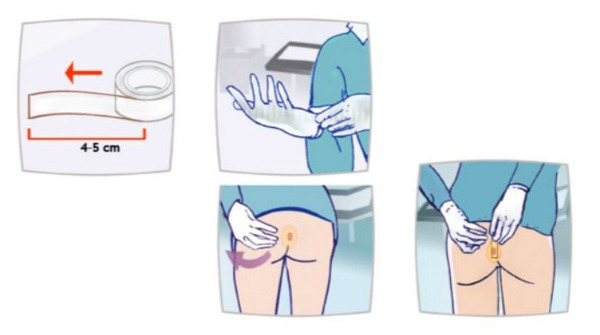

This procedure is carried out using a cotton swab smeared with petroleum jelly, or adhesive tape, which is glued to the skin of the perineum. A swab is taken immediately after waking up before going to the toilet without prior preparation.
The taken material is placed inside a sealed container, quickly delivered to the laboratory. It can only be stored for a few hours in the refrigerator. To obtain a more accurate result, scraping is recommended three times at intervals of two weeks.
Ways of pinworm infection in children


Drits Irina Alexandrovna. Parasitologist Helminthiasis can lead to numerous health problems, shortening life by 15-25 years. Many parasites are extremely difficult to detect. They can be anywhere - in the blood, intestines, lungs, heart, brain. Symptoms of helminthic invasion can be confused with ARVI, gastrointestinal diseases and others. The main mistake in such cases is procrastination! If you have any suspicions about the presence of parasites, then you need to contact a specialist. More information about modern methods of treating helminthiasis is described in this interview with a doctor... If we talk about drugs and self-treatment, then from the most common helminths (ascaris, pinworms, tapeworms), this antiparasitic complex.
Since the child leads an active life, he tries in every possible way to study the world around him, contacts with animals, plays with other children, several main ways of pinworm infestation can be noted:
| Way | Description |
| Oral | Anything a child touches can be contaminated with eggs. Children try to taste everything - this is the main way of infection. After contact with an infected object, the child must pull dirty hands into his mouth, thereby becoming infected. |
| Domestic | Contact with dirty toys, eating unwashed food. This is the most common way to catch pinworms. In any case, the eggs enter the mouth, and then the child swallows them along with saliva. |
| Contact | Pets and stray animals are potential carriers of parasites. Having played with an animal and after that without washing your hands is a sure way to get infected with helminths. |
Spreading eggs
Pinworms infect only the human body - it is its final and only host. Basically, this pathology is found in families in which babies are growing. Pinworms are capable of being actively transmitted from person to person, therefore, when diagnosing this pathology in any of the family members, everyone must undergo a course of treatment. This spread is due to the biological characteristics of the helminth. The oviposition process takes place:
- in the anal area;
- on bed linen;
- in the area of the gluteal muscle;
- it is accompanied by the release of isovaleric acid, which causes severe itching in humans.


Due to scratching, parasitic eggs move to fingers or under nails, from which they spread through the environment, and settle together with dust particles. In the environment, they can maintain their ability to live for a sufficiently long time, which significantly expands the pathways of infection with enterobiasis.
Often, infection is diagnosed in babies who are 5-10 years old. Sometimes there is an invasion of crumbs that have not reached 2 years of age. Therefore, these helminths are also called children's pinworms.
Sometimes pinworms are diagnosed in pregnant women. Basically, this situation occurs when an older child picks up this pathology and spreads it among family members, not observing the rules of personal hygiene.
A pregnant woman should not sound the alarm after contracting enterobiasis, since these helminths are not capable of harming the unborn baby. However, in this position, the risk of infection of the crumbs during childbirth increases. Therefore, a pregnant woman is obliged to eliminate pinworms from her body using special medications.
Reasons for re-infection
Failure to comply with the rules of personal hygiene - dirty hands, linen are favorable factors for the development of enterobiasis. Relapse can occur if you do not undergo repeated treatment, ignore preventive measures.
Usually, a couple of weeks after the first course of treatment, you need to undergo a second examination and therapy - this is necessary to eliminate the likelihood of relapse.
Enterobiasis is a common disease provoked by pinworms. If a person goes to a medical institution on time, the treatment is quick and easy.
To prevent infection, it is important to observe preventive measures, to abandon self-medication when negative symptoms appear. This can seriously affect the state of health, complicate the process of recovery and diagnosis of the disease.
Treatment of enterobiasis
The source of enterobiasis is a person, therefore, this disease should be treated in a comprehensive manner, influencing the causes of this helminthic invasion. When an infected person appears inside the family, everyone needs to be treated. Therapy necessarily takes place against the background of strict adherence to the rules of personal hygiene, maintaining the cleanliness of the room, and disinfecting sanitary points.
Full treatment is carried out within a month, since the life cycle of these parasites is 3-4 weeks. If a new infection is not allowed, then during this time the pinworms die even without medicinal effects. A correctly selected treatment regimen, medicines and folk remedies improve the therapeutic result.


With deep infection with pinworms, it is not recommended to self-medicate, but it is better to seek medical help. An experienced doctor uses the same medicines for effective therapy of children and adults, but the dosage and combination of medicines is determined in each case.It depends on the weight, individual characteristics of the patient's health.
For greater effectiveness of treatment, it is not recommended to eat stool-strengthening foods a day before taking medications.
In parallel with anthelmintic drugs, antihistamines are used to combat allergic manifestations and laxatives.
Among the main drugs are Mebendazole, Pirantel, Levamisole... For severe invasions, it is used Nemosol... This drug, along with a strong anthelmintic effect, has many side effects. On the other hand, a medication Piperazine prescribed even in cases when pregnant women become infected. The likelihood of treatment success is increased by a repeated course, which is recommended after two weeks.
You can defeat parasites!
Antiparasitic complex® - Reliable and safe disposal of parasites in 21 days!
- The composition includes only natural ingredients;
- Does not cause side effects;
- Absolutely safe;
- Protects liver, heart, lungs, stomach, skin from parasites;
- It removes the waste products of parasites from the body.
- Effectively destroys most types of helminths in 21 days.
There is a preferential program now for free packaging. Read expert opinion.
Prophylaxis
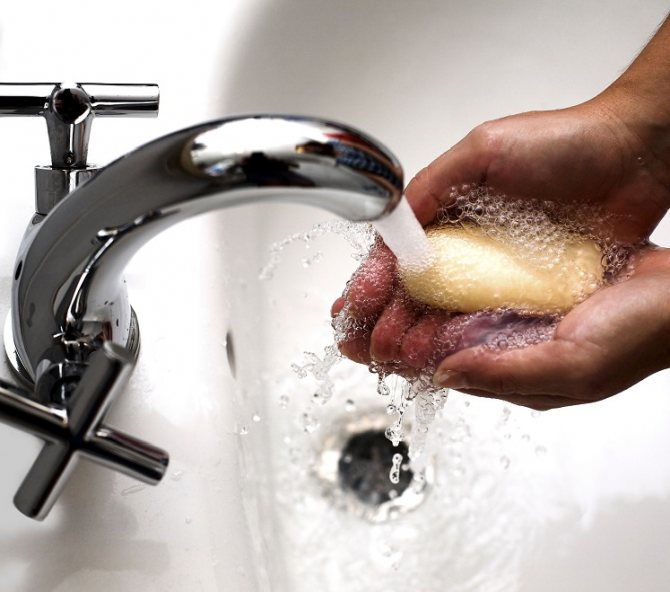

Hygiene measures take a special place. A person infected with pinworms should thoroughly wash their hands after each visit to the toilet, often change underwear, carry out regular wet cleaning in the apartment, monitor the diet, using onions, garlic and spices that will help expel parasites from the body.
Parents from an early age should teach children not to bite their nails, not take toys and other objects in their mouths, wash their hands often, especially after visiting public places, playing with animals, peeling vegetables and fruits before eating.
Is it possible to "get" worms when kissing through saliva?
Experts are discussing whether it is possible to penetrate worms from a person through a kiss, but they do not come to a definite answer.
Despite the fact that this route of infection is unlikely, it is still recommended to be careful in this regard. This is due to the fact that there is also an opinion that some types of helminths from the genus Ascaris or pulmonary flukes can enter the body from a sick person through saliva
Therefore, you should consider this possibility and remember about the possible consequences.


Clinical picture
With a mild course of enterobiasis, patients are worried only about the evening itching in the perianal region. Attachment to microtraumas of the skin of a secondary bacterial infection leads to dermatitis. When the infection penetrates deep into the tissues of the rectum, sphincteritis or paraproctitis develops.
Sometimes pinworm causes intestinal dysbiosis, which will manifest itself as cramping abdominal pains, frequent mushy stools mixed with mucus.
In women, the parasite can crawl into the genitals, causing vaginitis and vulvovaginitis. The female in the process of further migration causes endometritis, and having penetrated the fallopian tubes into the abdominal cavity - inflammation of the pelvic peritoneum (peritonitis).
The most severe complications of enterobiasis include appendicitis. Against the background of inflammatory changes, the wall of the appendix becomes especially vulnerable to perforations due to the activity of pinworms. Fecal peritonitis develops.
Ways of transmission of worms from person to person
Did you know that statistics from the entire globe claim that a third of the population is carriers of helminths? In fact, this is so, so the question of how worms are transmitted is especially acute. In total, there are more than 340 varieties of parasites, but not all of them parasitize in the human body. However, most of them have the same infection methods.You need to know that in an adult state, worms are transmitted extremely rarely, but they are easily introduced into the human body in the form of larvae and eggs.
Having penetrated into a person, they begin to slowly develop and grow, then multiply. If a person does not take any measures, the worms are transmitted to other organisms in different ways. Almost all parasites are equipped with a sticky membrane, due to which they easily attach to tissues and mucous membranes of the human body. For example, having adhered to the skin under the nails, the eggs of the worms easily penetrate into the mouth, eyes and other organs. They can also be fixed on household items - a towel, bed linen, etc. And this already allows them to penetrate into the body of a completely different person. Initially being in any habitat (water, soil, household items), helminths seem to expect contact with human skin, after which they instantly adhere to the epidermis and migrate into the body.
Any kind of parasite quickly and easily takes root in a new person, because the habitat is favorable. That is why it is important to take timely preventive measures against worms.
Is it possible to get infected with worms in the pool?
The pool, in contrast to a natural reservoir, is considered less dangerous in terms of infection with helminths, since the water goes through the disinfection stage - it is chlorinated. However, if a sick person entered the water, and you stood next to him for a couple of minutes, the parasites will easily attach to you, after which they will immediately begin to invade the body.


But there is also a type of invasion (lamblia), which is not afraid of chlorinated water. These parasites remain vital even in such an environment. For this reason, before visiting the pool, a doctor's certificate is required about the absence of worms and other diseases.
If you trust the responsibility of the employees of the institution, you can safely visit the pool. Because in this case, the infected person will not be allowed to bathe. For complete safety, it is better to visit the private pool, where you will know for sure that there was no sick person in the water.
Are worms transmitted through saliva and kissing?
Worms do not live in the mouth because saliva acts as a protective barrier against infection. But the likelihood of infection is still there. This is possible in such cases:
- if one of the partners ate a food product contaminated with worms before kissing;
- if the child took an infected toy in his mouth, and his mother immediately kissed him;
- if, while swimming in a pond, you swallow some water saturated with parasites, and immediately kissed your partner.
In a word, infection through saliva and kissing is possible only if, before contact with another person, there was contact with helminth larvae.
Can you get infected with worms by eating sushi?
Rolls and sushi are now so popular that they are consumed in huge quantities by people every day. They attract mankind not only by the sophistication of taste, but also by their low calorie content, rich in nutrients. But sushi is different. Many recipes have already been invented in which not raw, but thermally processed fish are used, which eliminates the risk of infection with helminthic infestations. If you consume rolls and sushi with raw fish, then it is quite possible that after that you will find helminths. Because almost 100% of the fish are infected.


The most dangerous species in this regard are perch, herring, salmon and cod species. Among the seafood are octopus, shrimp, squid. Types of worms parasitizing in fish and seafood:
- Siberian fluke (opisthorchiasis occurs) is found in rudd, bream and tench most often;
- broad tapeworm contributes to the development of diphyllobothriasis, is found in salmon, ruff, pike;
- the Chinese fluke develops kloronkhoz, and the nematode develops nanofietosis, these worms live in sloth, whitefish, taimen;
- the trematode leads to metagonism, lives in cyprinids, trout and bream;
- anisakidosis disease develops against the background of parasites that exist in herring fish species;
- ligulosis develops due to the ligature.
Are worms contagious in a child?
Worms are contagious in and of themselves, so it doesn't matter which organism they are in - a child's or an adult's. It is often enough that the parent takes the child by the hand after playing in the sandbox containing the eggs of the parasites. In this case, the person is instantly infected.
Who can get infected?
Children under 3 years of age are at greatest risk of pinworm infection. The high survival rate of enterobiasis pathogens ensures the ability of their eggs to stay outside the human body for a long time, while maintaining their viability. Among children, it is customary to distinguish special categories that are at risk of pinworm infection:
- Children whose mothers during pregnancy suffered severe forms of toxicosis (gestosis) or had a number of other complications during the period of bearing a child;
- Children who received artificial baby food instead of mother's breast milk. This is due to insufficient intake of natural immunoglobulins in the child's body with breast milk;
- Groups of children prone to frequent colds and allergic reactions;
- Separate groups of children with mental and physical disabilities;
- Children living in dwellings with insufficient living and sanitary conditions;
- Children prone to nail biting.
Animals do not get sick with enterobiasis, although they can carry eggs that accidentally hit them. Most often, pinworms in children appear upon contact with peers who are already infected.

